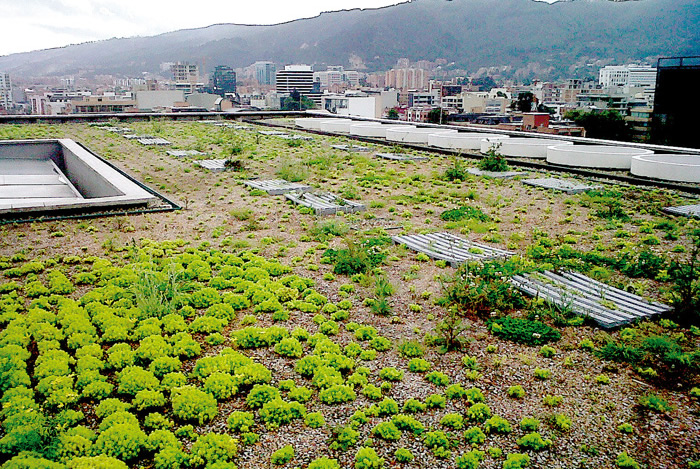This practice, known as biotechtonics (to build a living material), has been integrated into architecture in places with big differences such as Norway, Tasmania and China. Despite its technological development is attributed to Germany, its adaptation to solve particular problems in the city is attributed to each country"s "master builder".
In Colombia, Ricardo Andres Ibáñez and Miguel Ángel Cárdenas, a Magister in construction and candidates to obtain the master"s degree in Architecture in the Faculty of Arts at Universidad Nacional de Colombia, thought Bogotá had all the conditions to "plant" this system in their buildings.
The environmental damage caused by this mayor city confirmed their intention: clime change, huge runoffs, lack of trees and green zones, natural habitat destruction, noise excess, visual contamination, lack of soil, etc.
That is why, taking up again some design criteria, production and construction of the German model, they developed ecologic extensive covers, a Creole technology, which includes special vegetation and recycle elements such as plastic and debris.
Their advantages are infinite: they capture 40% of rain water, produce oxygen, they do not need maintenance, isolate noise up to 8 decibels, increase the commercial value of the property, rebuild the natural landscape, isolate the temperature of the building reducing energy consumption, capture PM10, promote biodiversity, increase the useful life of the impermeable concrete cover from 5 to 40 years, create recreational spaces, reduce visual contamination, reduce heat, can be use in public or private buildings, schools, residential complexes and critical places in the city.
The results of their proposal can be seen in several constructions in Bogotá: three office buildings at north, residential complexes such as Ciprés de la Arboleda (in Quinta Paredes) and Pietramonte (In Rosales), two libraries (The Study Center, CEDE, at Los Andes University and in Socorro, Santander) and in a house in la Calera. Meanwhile, they are preparing 5 more projects.
They are in China
But that"s not all. Currently, they are in the biggest exhibition in the entire world ever: Exposhangai 2010, which motto is "better city, better life". It began last may 1st and its organizers expect, until next September, close to 70 million visitors, that is why they invested 4.2 million dollars, two times more than what they invested in the Olympic Games.
In one of the most important financial and economic centers in China, the professionals from Universidad Nacional de Colombia stand out with his work among other alternatives that are looking for the application of alternative and ecologic energies of low carbon to save energy and reduce pollution. In addition, Colombia was included in the world infrastructure of green roofs and walls network. Furthermore, they were asked to design a green roof"s manual for Bogotá and they are getting ready to tell about their experience in a world congress in México.
What an achievement! Isn"t it" Incredible, he began digging holes with a pickax and a shovel. Do you wanna know what happened" You can read the report in the 20th issue of Matices. The Stories behind the investigation.
Web page
 Correo Electrónico
Correo Electrónico
 DNINFOA - SIA
DNINFOA - SIA
 Bibliotecas
Bibliotecas
 Convocatorias
Convocatorias
 Identidad UNAL
Identidad UNAL



